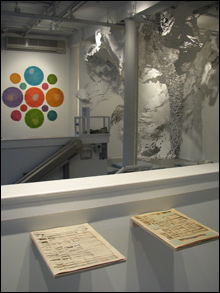
CARTOON PIONEER: Relations between the sexes was a favorite topic of Marjorie Henderson Buell.
Image courtesy of the Schlesinger Library at the Radcliffe Institute for Advanced Study.
|
“20th Drawing Show: Drawing The Line” Boston Center for the Arts’ Mills Gallery, 539 Tremont St, Boston | Through January 6 | “Little Lulu Lives”
Schlesinger Library, Radcliffe Institute for Advanced Study, 10 Garden St, Cambridge | Through March 28
|
A man with an ax walks out onto ice crusting over part of a pond and proceeds to chop a wavy line. In Virginia artist A. Jacob Galle’s 2004 black-and-white video 4.11.04 ice cutting, the fellow — the artist himself, it seems — straddles the crack as he works backward. He sheds his coat or sweater as he heats up. The sunlight fades from the pond and the surrounding birches and evergreens as the day passes. Galle stands in the water in his tall boots and hacks apart bits he missed. At last he pushes the floating sheet of ice free. It spins slowly, magisterially, out toward the middle of the dark water.
It is a curious and simple and magical performance. And it’s one of the highlights of the Boston Center for the Arts’ “20th Drawing Show: Drawing the Line.” Brookline artist Maria Magdalena Campos-Pons served as guest juror, working with the BCA’s Mills Gallery, to narrow down 480 applicants to 26 participating artists.
Galle’s performance is clearly inspired by the 1960s and ’70s earthworks of folks like Michael Heizer and Robert Smithson, right down to their macho-nature-boy destructiveness — though in this instance the destruction is a very temporary scar. And like those works, 4.11.04 ice cutting speaks of artists’ elemental desire to make their mark on the world.
Drawing has taken a central place in art over the past decade, particularly among artists asserting the handmade and human in our synthetic digital age. And there’s been some great local drawing produced in recent years — work by Somerville’s Mary O’Malley, Cambridge’s Todd McKie, and Providence’s Brian Chippendale, among others. Providence’s TinyShowcase.com is devoted to presenting prints by artists whose work is driven by drawing. Sharp drawing has begun to emerge from students at Vermont’s Center for Cartoon Studies.

PUSHING THE ENVELOPE: At the Mills
Gallery, Pat Shannon’s Cape Cod Times
(foreground) and Mia Pearlman’s Nigh (right)
qualify as “drawing.”
|
But “Drawing the Line” is one of those genre-busting exhibitions aimed at “rethinking the traditional approach to drawing as a medium.” The show offers embroidery, videos, sculpture, wall paintings, knitting, wires wrapped in colored thread to resemble veins or tree branches, and — oh, yeah — some drawing. We get a snapshot of the Boston scene (with some outside guests); that’s a worthy project in itself, but it’s not so much about drawing. Moreover, the focus on emerging artists, many of whom are still working things out, means that the art is very hit-or-miss.
In Cape Cod Times, Dorchester’s Pat Shannon sliced out all the articles, pictures, and ads from a June edition of the newspaper and hung the 12 sheets one behind another from a metal rack, as if they’d been left out to dry. The pages have a fragile lacy quality. When you peer through the diced layers, they resemble the grid of cities or some sort of skeleton. There’s a peacefulness as all busy noise of news is silenced. But there’s also something creepy in everything’s being redacted.
Cambridge’s Marilyn Pappas, who retired from MassArt in 1994 after teaching there for 20 years, offers two large, elaborately hand-embroidered tapestries inspired by classical Greek and Roman statuary that she’s seen during travels in Europe over the past 15 years. In History Lessons: Nike, Goddess of Victory, a headless winged sculpture of a woman, partly nude in a sheer gown, walks between a crumbling column and a vase that topples and shatters. A banner floating in the air reads, “At what cost victory.”
Worcester artist Laura Schomp also uses stitching. In Father, Daughter (2007), she sketchily embroidered black thread into a pair of white napkins. The left napkin depicts her dying father. The right is a self-portrait showing her in a hospital preparing to give birth to her first child. Lots of loose threads dangle to the floor, as if the life were draining out of the people. The imagery is clumsy, but the pieces feel a bit like holy relics.
Somerville artist and designer Dave Ortega’s Apocalypse (Quaint/Cuddly Remix) (2007) turns explosions and clouds raining fire into bright cut-out vinyl cartoons resembling Colorforms that he sticks onto the gallery windows. A fun mix of cute and dark, it lacks some of the snap of Ortega’s hot, slick, superflat graphic design. Rosanna Castrillo-Diaz of San Francisco turns transparent tape into lovely, delicate webs that resemble bubbles or cells floating across the walls.